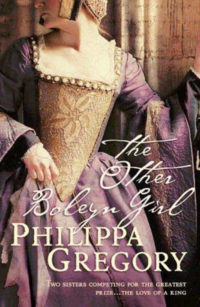It was her doom that came in that day
 The Other Boleyn Girl
The Other Boleyn Girl
by Philippa Gregory
I used to read Philippa Gregory a fair bit, back in my teens and early 20s, but until last week I hadn’t picked up one of her books in 14, 15 years. I associate her with a certain type of easy-reading historical romance that appealed to young me, particularly in my teens, with risqué sex scenes that I suspect I wasn’t emotionally ready for.
It probably didn’t help my opinion of Gregory that I tended to confuse her with Philippa Carr, another writer of historical romances that I loved as a teenager. My Mum introduced me to Carr (historical family sagas with lots of romance), along with her alter egos Victoria Holt (gothic romance) and Jean Plaidy (more serious historical fiction, which young me wasn’t a fan of). Carr’s Daughters of England series ambitiously traced the women of one family line from the early 16th century to the 20th century in 20 books, of which I think I read and adored the first 10 before I outgrew them. Perhaps I am judging them harshly in hindsight, but when I was 19 or 20 I decided they weren’t that good and stopped buying them.
Which is a long-winded way of saying that I tried and probably failed to come to this book with an open mind. I had also already seen the film, not to mention studied the Tudor period of British history multiple times at school (it’s not a running joke for nothing). So maybe I’m not objective, but I didn’t think was a great book.
“Her hand, when she gave it to him to kiss, was steady as a rock. Her voice was sweet and perfectly modulated. She greeted the cardinal with pleasant courtesy. No-one would ever have known from her behaviour that it was her doom that came in that day, along with the sulky ambassador and the smiling cardinal. She knew at that moment that her friends and her family were powerless to stop her. She was horribly, vulnerably, completely alone.”
It’s the story of Anne Boleyn and her sister Mary Boleyn, who both vied for the attention of King Henry VIII while he was despairing that his first wife, Katherine of Aragon, had grown too old to give him a son. Henry obsessed about this, and Britain’s powerful families endeavoured to take advantage of this by putting their young girls in front of the king, knowing that his mistresses could win great favour for their families.
The Boleyn sisters’ father, Sir Thomas Boleyn, and their uncle Thomas Howard, the Duke of Norfolk, noticed that the king was attracted to Mary and plotted to make her his mistress, making both Anne and their brother George help. When the king tired of her and looked to Anne instead, the Boleyn and Howard families switch to helping her instead, but unlike her sister, Anne refused to sleep with the king until he found a way to marry her.
The book is narrated by Mary, which gives Gregory a little more room for interpretation than if she had centred the story on Anne, whose history is better documented. Gregory notably departs from the accepted version of Mary, but this is fiction, after all. She creates a believable interpretation of a young woman manipulated by her family, too young to stand up for herself. Similarly, the relationship between the sisters is believably filled with love and hatred, jealousy and devotion.
“I said nothing. I just looked at him. If Anne or George had been close by they could have prompted me with some compliment. But I was empty of wit, it was all crowded out by desire. I could say and do nothing but just look at him and know that my face was full of longing. And he said nothing too. We stood, gazes locked, intently interrogating each other’s faces as if we might understand the other’s desire from his eyes.”
It’s a very readable book – I got through its more than 500 pages of tiny, dense text in just a few days. But I didn’t mark a single quote as noteworthy and in the early chapters I often found the phrasing a little clumsy and/or obvious. But by the second half, it was the story itself that annoyed me. Early on, Gregory drops in innocent circumstances that might lead to the testimony that was given about Anne Boleyn that led to her execution, which I really appreciated. She starts out as an innocent, albeit a smart and scheming one. But later Gregory makes her vicious and guilty of some terrible things (again, defying the consensus of historians). This, like the choices she made about which version of Mary to write, seems to have been done purely for the shock value. (For instance, this Mary is married off at 12 and the king’s mistress at 14, bearing him a child when she is just 15. Which is not impossible in the 16th century but unlikely in Mary’s case.)
Mary is a very likeable heroine, but I think the scholar in me would prefer more accurate facts and less concern about likeability. And better writing.
Published 2001 by HarperCollins.
Source: Library at work.